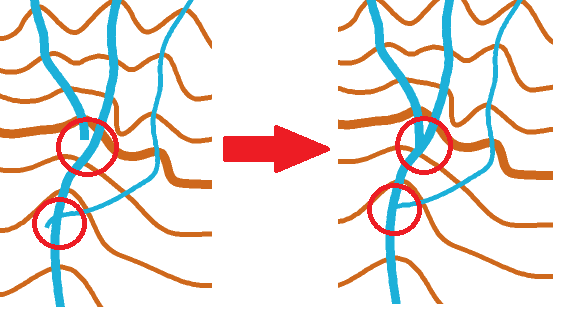Topologie: Unterschied zwischen den Versionen
FBO (Diskussion | Beiträge) |
FBO (Diskussion | Beiträge) |
||
| Zeile 9: | Zeile 9: | ||
====Automatic Joining==== | ====Automatic Joining==== | ||
If you enable [[File:Icon_AutomaticJoining.PNG]] '''Automatic Joining''' in the '''Edit Functions Toolbar''', end points of lines are joined automatically when | If you enable [[File:Icon_AutomaticJoining.PNG]] '''Automatic Joining''' in the '''Edit Functions Toolbar''', end points of lines are joined automatically when finishing drawing a line near another line end. | ||
====Tolerance Value==== | ====Tolerance Value==== | ||
Version vom 4. Juni 2012, 08:39 Uhr
The Topology submenu can be found in the Object menu.
Join
Choose the Join function in the Topology submenu of the Object menu or in the Edit Functions Toolbar.
This function is active if a line object is selected.
Use this function to adjust adjoining line ends so that they coincide. Only line objects with the same symbol are joined. This is especially useful when continuing a line object such as a contour. Note that the objects remain independent objects, but the coordinates of the end vertices are equalized. If you want to merge objects, choose the Merge command.
Automatic Joining
If you enable Automatic Joining in the Edit Functions Toolbar, end points of lines are joined automatically when finishing drawing a line near another line end.
Tolerance Value
Define how close two line end points have to be for joining them in the Drawing and Editing category of OCAD Preferences.
Select Duplicate Objects
Choose this function from the Topology submenu of the Object menu.
With this function you can find all duplicate objects. The objects must be identical and on the same position that they can be found.
![]() Objects with different symbols whose geometry is identical are not selected.
Objects with different symbols whose geometry is identical are not selected.
Select Self-Intersected Objects
Choose this function from the Topology submenu of the Object menu.
This function selects all line, area and line text objects with a self-intersecting geometry. The selection can be saved right after carrying out the command (Save a Selection).
Select Line Text Objects with too Short Line
Choose this function from the Topology submenu of the Object menu.
This function selects all line text objects whose text is longer than the line length. This can happen when the font of a text symbol has been increased. The selection can be saved right after carrying out the command (Save a Selection).
Close Area Objects
Choose this function from the Topology submenu of the Object menu.
This function closes the desired area(s).
- Select the area objects to close either in the drawing area or in the symbol box. Do not select any area object if you want to close all area objects on the map.
- Choose the Close Area Objects command in the Topology submenu of the Object menu.
- The Close Area Objects dialog appears.
- Choose wheter you want to close all area objects, all area objects from the selected symbols or all selected are objects on the map.
- Click the OK button to finish. OCAD closes the desired areas (which means that the end and start point of an area object have the same coordinate).
![]() OCAD is able to close area objects automatically when drawing. Enable the Close area objects when drawing option in the Drawing and Editing category of OCAD Preferences to activate this function.
OCAD is able to close area objects automatically when drawing. Enable the Close area objects when drawing option in the Drawing and Editing category of OCAD Preferences to activate this function.
Remove Overshoots and Undershoots
Choose the Remove Overshoots and Undershoots command in the Topology submenu of the Object menu to remove over- and undershoots of the selected lines.
This command is enabled when line objects are selected.
- Select the line objects with over- and/or undershoots.
- Choose the Remove Overshoots and Undershoots function.
- The Remove Overshoots and Undershoots dialog box appears.
- Decide wheter you want to remove overshoots, undershoots or both of them.
- Define a tolerance value. This value determines how much a line must over- or undershoot so that it gets cut or extended.
- Click the OK button to finish.
![]() If you want to prevent from creating under- and overshoots, enable the Snapping function.
If you want to prevent from creating under- and overshoots, enable the Snapping function.
Insert Intersections
You can find this function in the Topology submenu of the Object menu. This command is available when two or more line objects are selected.
- Select two or more line objects.
- Choose the Insert Intersections function.
- The Insert Intersections dialog appears.
- Choose wheter you want to insert a Normal Vertex a Corner Vertex or a Dash Vertex (Read more about vertices on the Vertices page).
- If desiresd, check the Insert vertices when a line is touching another line option.
- Click the OK button to finish.
This function can be useful if you want to improve the graphic appearance of dashed lines' intersections. For example, if you insert a Dash Vertex, the intersection will be in the middle of a dash (Learn more about vertices on the Vertices page).
Back to the Edit Object page.
